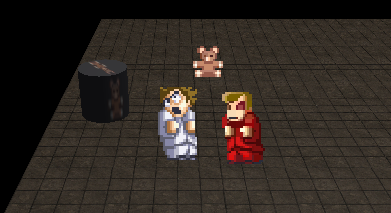
A couple of months ago, I was having a conversation with some game developer friends of mine when one asked, “In music, there are few original indie musicians out there. Oftentimes they sound same-y based on their regional influences. Is this similar when it comes to video game design?”
Many beginning indie game developers follow suit with indie musicians, where they decide to focus on building games that they grew up playing. There’s not necessarily anything wrong with this per se; the world benefits from creativity being unleashed. However, it can become a challenge for them to gain traction and stand out among the throng of games being released daily if they stick to the same core gameplay as those they played as a kid. What used to be able to exist as a genre in and of itself back then no longer has the same engagement nowadays, except in some rare cases of nostalgia.
I ran into this situation when serving as BAKLAVA‘s technical producer and game designer. We set out to build an arcade-style single-screen brawler as part of a VR arcade that existed inside another title being developed by Games for Love teams, so the original mechanics weren’t very deep; players would move their character around the screen and push buttons to beat up enemies, similar to Double Dragon and Final Fight from the late ’80s, and would fight wave after wave of enemies as they refilled the screen. We eventually were asked to build this game as a standalone release, so we shifted the team accordingly and began building a prototype for the game based on these simple mechanics. However, we presented to Games for Love’s game review board, which gives feedback for games in development, and we were told that the mechanics would not be enough to engage players with a sense of progression and get them to want to see the end of the game. One suggestion we received was to see if other genres could work well with the brawler genre and see if their mechanics could be combined meaningfully. We took that feedback to heart and rebooted the game to make it stand out from the rest of the brawler genre.

As I thought more deeply about genre mechanics when it comes to game design, I started to see that not all genres are equal. I felt that most, if not all, game genres could be separated into two categories, “core genres” and “genre addons:”
- A core genre is a genre that critically impacts the mechanics of a game, such that adding multiple core genres significantly hinders the cohesion of the mechanics. Having three or more core genres, such as a tower defense stealth survival horror game, can be hard to make work, but having two core genres, such as a tower defense stealth game or a stealth survival horror game, tends to be manageable and introduce interesting dynamics between the two genres’ mechanics.
- A genre addon is a genre whose elements can be applied to core genres to enhance them and they work well alongside other genre addons. For example, an open-world Metroidvania brawler (core genre) with puzzle platforming, roguelike, and survival crafting elements could technically work. Genre addons also tend to be genres in games from the 80s and 90s that were core genres but became prolific enough that they no longer stand out amongst the crowd on their own (e.g., platformers).
Some examples of core genres and genre addons include:
| CORE GENRE | GENRE ADDON |
|---|---|
| 4X (e.g., Civilization) | Arcade (lots of numbers, sounds, and flashy lights) |
| Action RPG (e.g., Diablo) | Crafting (collecting resources to create tools and structures) |
| Auto Battler (e.g., Auto Chess) | Metroidvania (sprawling maps, incremental powerups) |
| Beast Capture / Minion Master (e.g., Pokemon) | Open World (large spaces, focus on exploration) |
| Brawler (e.g., Double Dragon) | Platformer (running and jumping challenges) |
| Bullet Hell (e.g., Gradius) | Puzzle (figuring out puzzles, putting pieces together as solutions) |
| Card-Based (e.g., Slay the Spire) | Roguelike (procedural generation, permadeath, differences each run) |
| Cooking (e.g., Overcooked) | RPG (character progression over time, ability specializations) |
| Fighting (e.g., Street Fighter II) | Survival (low resources, persistent threats) |
| First-Person Shooter (e.g., Quake) | |
| Real-Time Strategy (e.g., Starcraft) | |
| Rhythm (e.g., Gitaroo Man) | |
| Stealth (e.g., Splinter Cell) | |
| Survival Horror (e.g., Resident Evil) | |
| Tactical RPG (e.g., Final Fantasy Tactics) | |
| Tower Defense (e.g., Bloons) | |
| Turn-Based Strategy (e.g., Advance Wars) |
In some cases, the genre can be tied to a particular game, similar to what the game Rogue is to Roguelikes. Some modern examples include “Souls-likes” (based on the Dark Souls game series’ fair but significant difficulty) and “Survivor-likes” (based on Vampire Survivors, which is a type of Bullet Hell/Roguelike/RPG combination).
Since two core genres mixed is the maximum in most cases when it comes to a cohesive combination of mechanics, here is a simple equation for creating an interesting starting point for your mechanics:
(Core Genre) + (Core Genre) + (At Least One Genre Addon) = Interesting Game Mechanics
Let’s consider some examples:
- (First-Person Shooter) + (Rhythm) + (Roguelike) = BPM: BULLETS PER MINUTE
- (Survival Horror) + (Stealth) + (Roguelike + Puzzle + Platformer) = Hello Neighbor
- (Auto Battler) + (Tower Defense) + (RPG) = Legion TD 2
- (Bullet Hell) + (Minion Master) + (RPG) = Boneraiser Minions
For BAKLAVA, we decided to use Brawler and Cooking as our core genres, with a touch of Crafting and Arcade added in; “Cooking” in our case translated into interacting with objects that had to go through several states to achieve a goal, similar to cooking a meal in Overcooked, but in our case, it involved objects more appropriate to the goal of the story scene in BAKLAVA, and at times multiple objects would have to be made and assembled to achieve a meta-goal for the scene. What this translated into gameplay-wise was four players would have to juggle Overcooked-like tasks while fighting off lava monsters spewing from the nearby volcano; some players would try running objects around the scene to reach their goals while other players would brawl with enemies to keep them from interrupting the others’ tasks. As part of exploring this genre mashup, I submitted an entry to a game jam I hosted in the Games for Love community to gather more “Brawler+” genre options for us to explore.

Once I put these genre mechanics together into a game design document and presented to the game review board what it could look like, the feedback we got was incredibly positive; one of the reviewers wondered what our timeline was simply because he would love to play a game like this. This finally gave us an exciting set of mechanics to prototype and hope for the future of the game! (Spoiler alert: For a variety of reasons, the game has not yet been completed and I unfortunately needed to step back from my leadership role in the game to rebalance work, family, and volunteering. Perhaps someday we’ll see this masterpiece!)
While this game genre equation is not a guaranteed path to success, and some may argue that mixing genres is a bad idea, my goal in sharing this with you is to give you another tool to try if you need a good starting place to begin your game design, especially for game jams, or if you are having trouble creating interesting gameplay mechanics with your current genre. Hopefully, in these cases, you can make use of this equation to help get some fresh ideas on how to spice up your gameplay!